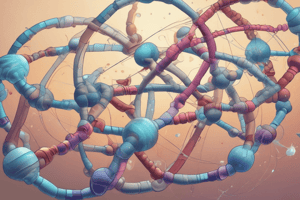Podcast
Questions and Answers
What is the primary goal of karyotyping?
What is the primary goal of karyotyping?
- To study the structure and function of chromosomes
- To diagnose genetic disorders
- To identify chromosomal abnormalities (correct)
- To visualize chromosomes in somatic cells
What type of chromosomal abnormality results from changes in the number of chromosomes?
What type of chromosomal abnormality results from changes in the number of chromosomes?
- Molecular abnormality
- Numerical abnormality (correct)
- Structural abnormality
- Mitotic abnormality
Which of the following is an application of karyotyping?
Which of the following is an application of karyotyping?
- Studying the structure of chromosomes
- Prenatal diagnosis of chromosomal abnormalities (correct)
- Cancer treatment
- Diagnosing viral infections
What is the term for errors that occur during meiosis, leading to chromosomal abnormalities?
What is the term for errors that occur during meiosis, leading to chromosomal abnormalities?
What is the study of the structure and function of chromosomes using molecular biology techniques?
What is the study of the structure and function of chromosomes using molecular biology techniques?
What is the consequence of chromosomal abnormalities on development?
What is the consequence of chromosomal abnormalities on development?
What is the term used to describe the presence of two or more cell lines with different chromosomal makeup?
What is the term used to describe the presence of two or more cell lines with different chromosomal makeup?
Which technique is used to detect specific DNA sequences or chromosomal regions using fluorescent probes?
Which technique is used to detect specific DNA sequences or chromosomal regions using fluorescent probes?
What is the term used to describe changes in the structure of chromosomes, including deletions, duplications, and translocations?
What is the term used to describe changes in the structure of chromosomes, including deletions, duplications, and translocations?
Which technique is used to detect copy number variations (CNVs) and chromosomal abnormalities using DNA microarray technology?
Which technique is used to detect copy number variations (CNVs) and chromosomal abnormalities using DNA microarray technology?
What is the term used to describe the presence of multiple sets of chromosomes in a cell?
What is the term used to describe the presence of multiple sets of chromosomes in a cell?
Which technique is used to detect genetic mutations and chromosomal abnormalities using high-throughput sequencing technology?
Which technique is used to detect genetic mutations and chromosomal abnormalities using high-throughput sequencing technology?
Flashcards
Karyotyping Goal
Karyotyping Goal
Identifying chromosomal abnormalities.
Numerical Abnormality
Numerical Abnormality
Change in chromosome number.
Prenatal Karyotyping
Prenatal Karyotyping
Diagnosis of chromosomal problems before birth.
Meiotic Errors
Meiotic Errors
Signup and view all the flashcards
Molecular Cytogenetics
Molecular Cytogenetics
Signup and view all the flashcards
Chromosome Abnormality Effect
Chromosome Abnormality Effect
Signup and view all the flashcards
Mosaicism
Mosaicism
Signup and view all the flashcards
Fluorescence in situ hybridization (FISH)
Fluorescence in situ hybridization (FISH)
Signup and view all the flashcards
Structural Abnormality
Structural Abnormality
Signup and view all the flashcards
Chromosomal Microarray Analysis
Chromosomal Microarray Analysis
Signup and view all the flashcards
Polyploidy
Polyploidy
Signup and view all the flashcards
Next-generation sequencing
Next-generation sequencing
Signup and view all the flashcards
Study Notes
Cytogenetics
Karyotyping
- Definition: Karyotyping is the process of creating an image of an individual's chromosomes to identify any abnormalities.
- Methods:
- Conventional cytogenetics: uses trypsin-Giemsa banding to stain and visualize chromosomes.
- Molecular karyotyping: uses fluorescence in situ hybridization (FISH) or array comparative genomic hybridization (aCGH) to identify genetic changes.
- Applications:
- Prenatal diagnosis of chromosomal abnormalities.
- Diagnosis of genetic disorders, such as Down syndrome.
- Cancer diagnosis and prognosis.
Chromosome Abnormalities
- Types of abnormalities:
- Numerical abnormalities: changes in the number of chromosomes (e.g., trisomy, monosomy).
- Structural abnormalities: changes in the structure of chromosomes (e.g., deletions, duplications, translocations).
- Causes of abnormalities:
- Meiotic errors: errors during meiosis can lead to abnormalities.
- Mitotic errors: errors during mitosis can lead to abnormalities in somatic cells.
- Consequences of abnormalities:
- Developmental disorders: abnormalities can lead to developmental disorders, such as Down syndrome.
- Cancer: abnormalities can contribute to the development and progression of cancer.
Molecular Cytogenetics
- Definition: Molecular cytogenetics combines molecular biology and cytogenetics to study the structure and function of chromosomes.
- Techniques:
- Fluorescence in situ hybridization (FISH): uses fluorescent probes to detect specific DNA sequences.
- Array comparative genomic hybridization (aCGH): compares the genomic DNA of two samples to identify copy number changes.
- Applications:
- Cancer diagnosis: identifies genetic changes associated with cancer.
- Prenatal diagnosis: identifies chromosomal abnormalities in prenatal samples.
- Genetic disorder diagnosis: identifies genetic changes associated with genetic disorders.
Studying That Suits You
Use AI to generate personalized quizzes and flashcards to suit your learning preferences.



